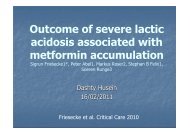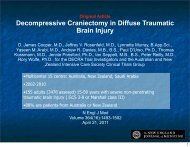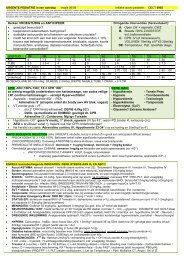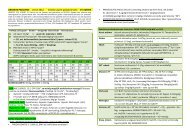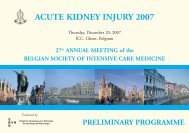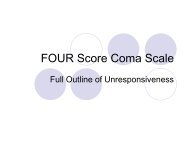Evidence-‐Based Management of An/coagulant Therapy - ICU
Evidence-‐Based Management of An/coagulant Therapy - ICU
Evidence-‐Based Management of An/coagulant Therapy - ICU
You also want an ePaper? Increase the reach of your titles
YUMPU automatically turns print PDFs into web optimized ePapers that Google loves.
<strong>Evidence</strong>-<strong>‐Based</strong> <strong>Management</strong> <strong>of</strong> <strong>An</strong>4<strong>coagulant</strong> <strong>Therapy</strong> Preven4on <strong>of</strong> VTE in nonsurgical pa4ents Preven4on <strong>of</strong> VTE in nonorthopedic surgical pa4ents <strong>An</strong>4thrombo4c <strong>Therapy</strong> and Preven4on <strong>of</strong> Thrombosis, 9th ed: American college <strong>of</strong> chest physicians <strong>Evidence</strong>-‐based clinical prac4ce guidelines Chest, february 2012 T Vandendriessche
Background and Methods • High-‐quality an4coagula4on management needed • narrow therapeu4c index: effec4ve safe • Randomized controlled trials(RCT) • Many lower-‐quality evidence (>50 pt per group)
Opdeling • <strong>An</strong>4<strong>coagulant</strong> <strong>Therapy</strong> • DVT pr<strong>of</strong>ylaxy in trauma pa4ents • DVT pr<strong>of</strong>ylaxy in cri4cally ill pa4ents (medical)
<strong>An</strong>4co: Specific for <strong>ICU</strong> • acute VTE: VKA therapy started on day 1 or 2 <strong>of</strong> LMWH or UFH therapy rather than wai4ng for several days to start – Meta-‐analysis 4 RCT DVT, PE, LV mural thrombosis – No differences in recurrent VTE, bleeding, death – early ini4a4on 4 days fewer in hospital • Stable therapeu4c INRs with a single subtherapeu4c INR value: against rou4nely administering bridging with heparin
<strong>An</strong>4co: Specific for <strong>ICU</strong> • decisions during maintenance VKA therapy: validated decision support tools • When taking VKA’s, avoid NSAID’s and AB (cotrimoxazole, quinolones, cefalo, metronidazole, amoxicillin, amoxiclav, fluconazole) • When discon4nuing VKA: abrupt not gradual tapering
<strong>An</strong>4co: Specific for <strong>ICU</strong> • If star4ng IV UFH, ini4al bolus (70-‐80U/kg) and Con4nu Infusion (15-‐18U/kg), weight adjusted or fixed dose 5000U, 1000U/h – 3 RCT weight based or fixed dose nomogram – Similar therapeu4c aPTTs – No evidence that monitoring improves outcome • Therapeu4c LMWH renal insufficiency (CrCL
VKA’s and high INR • INR 4,5-‐10 and no bleeding: no Vitamine K – 4 RCT’s compared vitamine K with placebo – Bleeding: Rates were similar, 2% vit K tg 0,8% placebo – TE 5/423 vit K, 4/441 placebo (not significant) – No evidence <strong>of</strong> benefit for outcome • INR > 10 and no bleeding: oral Vitamine K – No randomised trials – Retrospec4ve study 89 pt – vitamine K 2mg PO compared withdrawal VKA, INR>5 day 3: 11%-‐46%
VKA’s and high INR • VKA-‐associated bleeding: – Rapid reversal desirable – PPSB: first choice – NO FFP: prepara4on, volume, allergic – Vitamine K, 5-‐10 mg IV or oral
Major trauma pa4ents • Inflamma4on, fractures, immobilisa4on, surgical interven4on -‐> high risk <strong>of</strong> VTE • Consequences <strong>of</strong> bleeding complica4ons • Risk factors VTE: – Spinal trauma, acute spinal cord injury – Trauma4c brain injury – Older age, male, black, – Complete paraplegie – >3 days <strong>of</strong> mechanical ven4la4on
Major trauma pa4ents • Risk factors <strong>of</strong> bleeding (base line risks) – trauma4c brain injury – Non opera4vely liver or spleen injury – Renal failure – Spinal column fracture with epidural hematoma – Severe thrombocytopenie and coagulopathy
Major trauma pa4ents • average risk <strong>of</strong> VTE (~3%) and average risk major bleeding: – LMWH/LDUH prevent 4 4mes as many non fatal VTE events as nonfatal bleeding complica4ons – mechanical prophylaxis prevent 4 4mes as many nonfatal VTE events (skin complica4ons) • High risk <strong>of</strong> VTE (~6%) and average risk bleeding – LMWH/LDUH prevent 10 4mes non fatal VTE as nonfatal bleeding complica4ons, and prevent 4/1000 death <strong>of</strong> PE – mechanical prophylaxis prevent 15 nonfatal VTE/1000 pa4ents
Major trauma pa4ents • High risk <strong>of</strong> bleeding – Low quality evidence – LMWH/LDUH: number nonfatal VTE events prevented = number nonfatal bleeding complica4ons – Mechanical prophylaxis prevents nonfatal VTE events
Conclusion Major trauma pa5ent • LDUH/LMWH or mechanical prophylaxis beler than no prophylaxis • High risk for VTE: adding mechanical to pharmacologic prophylaxis • If CI for LMWH/LDUH, mechanical beler than no prophylaxis, adding LMWH when risk diminshes • IVC filter should not be used for primary preven4on • Periodic surveillance with VCU should not be performed
Medical pa4ents • Risk <strong>of</strong> VTE depends on (no validated) – Acute illness, chronic illnesses, prehospital diagnosis, <strong>ICU</strong> specific exposures (MV,CVC,…) • Risk <strong>of</strong> bleeding: – 80% 1 or more episodes <strong>of</strong> bleeding (minor)
Medical pa4ents: results • No ultrasound screening for DVT • LMWH or LDUH thromboprophylaxis or mechanical prophylaxis beler than no prophylaxis • Pt bleeding or at high risk for major bleeding, mechanical prophylaxis with GCS (graduated compression stockings) or IPC (intermilent pneuma4c compression) un4l the risk decreases



![JournalClub02april2008RRT[1] [Compatibility Mode] - ICU](https://img.yumpu.com/49889155/1/190x134/journalclub02april2008rrt1-compatibility-mode-icu.jpg?quality=85)
